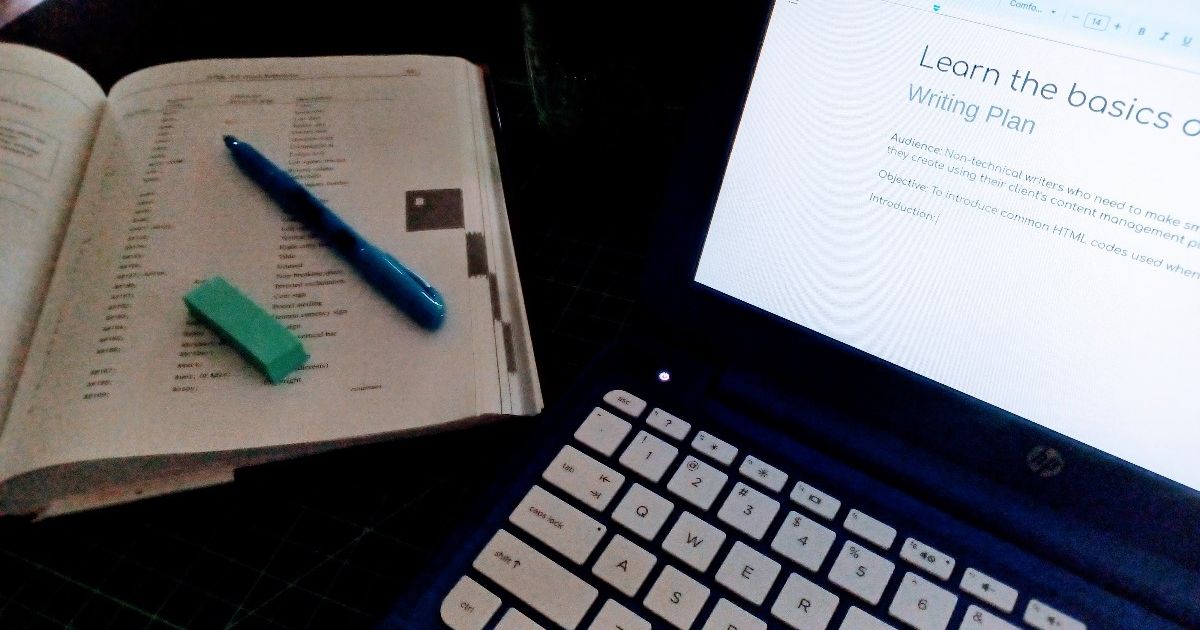Before you start tapping out words on your keyboard, begin your writing project with a writing plan. You’ll make a good first impression when you have a solid plan. And when you make a good impression, you attract readers to your writing.
Then, all you need to do is convince them to stay around by presenting yourself honestly and with well-written words.
When you write with a plan, you’ll create clear and compelling content readers will remember, and you’ll become a credible information source for your audience.

TL;DR
- Starting your writing project with a plan makes a good first impression and attracts readers to your writing.
- A writing plan is a roadmap that guides your writing process and keeps you organized and focused.
- A writing plan includes the audience, main objective, introduction, body, supporting details, conclusion, transitions, and schedule.
- Having a writing plan fosters audience engagement, helps organize your thoughts, and keeps your writing on track
- A writing plan helps you produce accurate and verified content and ensures you meet your deadlines.
Create a writing plan to reach your goals
A writing plan is a roadmap that guides your writing process. It keeps you organized and focused on the content. Plus, you’ll write content that follows a logical order. Think of it as a reference point and a framework to keep your articles, reports, training materials, and books on track.
The goal of a writing plan is to make sure the content is appropriate for your audience and communicates the intended message.
Some people refer to a writing plan as an outline. Large publishers refer to it as a proposal. No matter what you call it, a writing plan guides your writing by providing a structured overview of the content. It outlines the main ideas, sections, and supporting details you plan to include in the final work.
A writing plan typically consists of several elements that give an overall picture of the planned content. Here’s what you’ll include in each of these elements:
- Audience. Describe the people who will be reading the content.
- Main objective. State the purpose or goal of the content.
- Introduction. Set the context, introduce the topic, and give background information.
- Body. Include the main points or arguments that support the central theme.
- Supporting details. List the evidence, examples, facts, and research that support and add credibility to each main point.
- Conclusion. Wrap up the main ideas and reiterate the central message, leaving the reader with a sense of closure or a call to action.
- Transitions. Ensure a smooth flow between sections and create coherence throughout the piece.
- Schedule. Specify when each step of the writing process will be accomplished.
A writing plan takes different forms depending on your preferences and the project’s complexity. It can be a simple bulleted list with a few notes, a hierarchical structure, or a more detailed outline with subheadings and subpoints.

Why it’s important to have a writing plan
I’ve tried writing without a plan. I failed, and I won’t do that again. When I wrote without a plan, my writing was disorganized, it didn’t follow a logical order, and it was difficult to stay on schedule. This writing job is difficult enough. A writing plan takes some of that stress away.
I learned the benefits of creating a writing plan when I wrote technical books. The publishers required a writing plan before they would sign a contract. And that writing plan needed to create a visual image in their minds of what the book would look like and how it would develop.
I make a habit of putting together a writing plan before beginning any writing project, whether it’s a 500-word article or a 500-page book. And these are the reasons why.
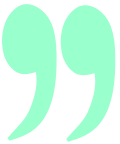
Getting an audience is hard. Sustaining an audience is hard. It demands a consistency of thought, of purpose, and of action over a long period of time.
Bruce Springsteen, American singer, songwriter, and musician
Fosters audience engagement
The first rule of writing is to know your audience. When defining your audience, consider why they need the information and what they want to accomplish after reading the content.
When you address an audience’s knowledge, requirements, and concerns, your content is engaging and relevant.
Your writing must reach an audience to be effective. Scribe Book School has tips that will help you identify your audience and create an audience profile.
Helps you organize your thoughts
When you have a structure you can reference, it’s easier to organize your thoughts and ideas in a logical and coherent manner. It identifies areas that need to be covered and if the content flows so that each paragraph builds on the information presented in the previous paragraphs.
When you give readers the guidance and information they want and present it in a logical order, they’re able to understand and apply the material.
Keeps your writing on track
When you can reference a structure while writing, your writing covers the main points. Plus, you’re less likely to get sidetracked or forget what you were going to say. It also keeps you from rambling and going off-topic. The result is clear and concise writing that effectively communicates your intended message.
Produces accurate and verified content
When you write nonfiction and technical content, you must spell names correctly, report the proper dates, and verify other facts. When you’ve done the proper research and added those details to your writing plan, the information you present will be accurate, supported by evidence, and consistent throughout the piece.
Makes sure you meet your deadlines
A writing plan helps you manage your time efficiently. When you follow a list of main topics, you won’t get stuck, and you’ll avoid that dreaded writer’s block. You also won’t spend an excessive amount of time on a section of the content.
Plus, while doing your research during the planning phase, you’ll identify the resources and references you’ll need before you start writing. Having this material ready is a big time-saver.
Streamlines the revision and editing process
When you’re done writing, editors can use the writing plan to save time and perform a high-quality edit. When editors have a document that defines your audience, topic, intent, and content flow, it’s easier for them to review and refine the material.
By using the writing plan as a reference, they can quickly identify areas for improvement, check for consistency, reorganize sections, and ensure the message is conveyed.

Tips for sticking to your writing plan
Sticking to a writing plan can be challenging. When you write without a plan, you’ll come up with ideas for additional content or may feel your outline needs to be reorganized. And this may happen when you’re almost finished with the piece. Not good.
To avoid this, research the subject matter and make sure your writing plan is complete before the writing begins.
A solid writing plan provides you with the strategies and mindset that increase your chances of success. Here are some tips to help you create a solid writing plan and stay on track while you’re writing.
Set clear goals
Define what you want to accomplish with your writing plan. Establish specific, measurable, achievable, relevant, and time-bound (SMART) goals. A clear purpose and target keep you motivated and focused.
TeamGantt explains what SMART goals are, offers tips and templates for setting SMART goals, and shows a few examples.
Eliminate distractions
Find a quiet and comfortable writing environment, turn off notifications on your electronic devices, and consider using productivity tools or apps that block distracting websites or apps during your writing sessions.
Break it down
Break your writing plan into small, manageable tasks. And set realistic deadlines for each task. You’ll maintain a sense of progress and accomplishment when you work in short, achievable increments.
Get into a routine
Consistency is key. Find the best times when you can productively write and set a schedule. Then, stick to your schedule.
Manage your time efficiently
Concentrate on only writing during the time you’ve scheduled. One way to stay productive is to work in focused bursts followed by short breaks to avoid burnout and maintain your concentration. Experiment with different methods and find what works best for you.
Be accountable to yourself
Set personal deadlines and create rewards and consequences for meeting or missing them. Consider sharing your goals and progress with a writing buddy, accountability partner, or mentor. Choose people who will provide support and keep you motivated.
Be flexible
It’s important to stick to your writing plan. Still, be open to revising and adjusting your schedule. Writing plans are meant to guide you. But when you discover new insights, decide whether it’s important to the content before you adjust your writing plan.
And if you choose to change your writing plan, keep the same overall structure and goals.
Pat yourself on the back
Celebrate and have a good time when you achieve a goal or meet a deadline. When you recognize your progress and give yourself positive reinforcement, it boosts motivation and inspires you to stick to your plan.
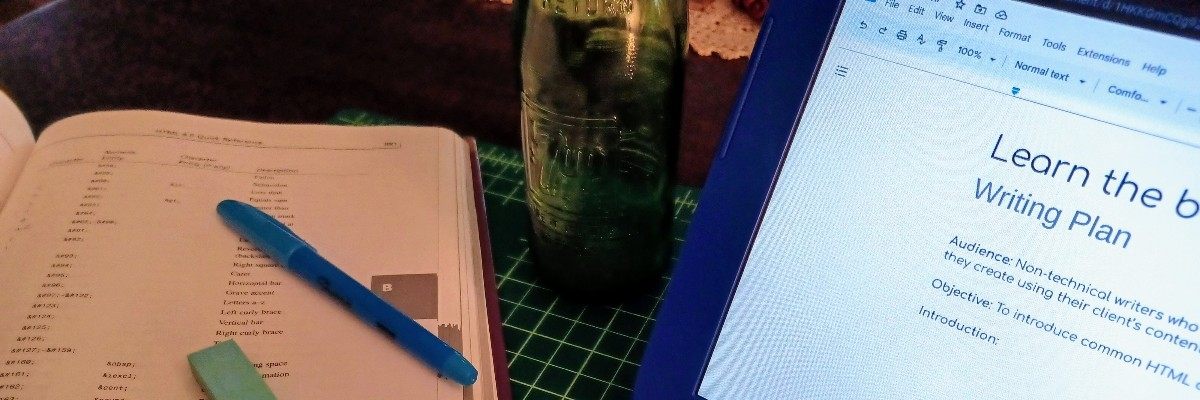
Tips for attracting an audience with a writing plan and effective copy
It takes planning to attract an audience for your writing. A plan gives your writing a purpose and a reason for your audience to keep coming back for more.
As you create your plan, decide on the type of information you want to share with your audience, organize your thoughts in an outline, decide how your content should appear on the page, and make a commitment to honesty and integrity.
A plan helps you create memorable content that convinces readers to join your audience.
Let’s look at the elements your writing plan and your writing needs so that you can write clear and compelling copy that attracts readers and captivates an audience.
Appeal and good design are the way to a reader’s attention
Readers are bombarded with information and don’t have time to read every piece of news or every story that crosses their screens.
If you want their attention, you must write well and your content must look good. Cluttered copy doesn’t cut it with busy readers. And nonsense headings will get your message nowhere.
Readers form a quick impression of your writing with a two-second scan. At this stage, they don’t care how well the words are written. They skim the text, read the large print, and decide whether they want to keep reading.
Here are some tips for making a good first impression with readers and attracting an audience:
- Make sure the topic and purpose of the document are clear.
- Format the writing using a layout that is easy to read.
- Write a descriptive title and use headings throughout the piece.
- Use bullet lists and numbered lists to break up paragraphs and create white space.
Be honest with readers, and they’ll come back again
After convincing your audience to read your writing, you must convince them to keep reading and become a part of your audience.
To accomplish this, be true to the impression you made on these readers. And, your writing must be as easy to read as it is to skim. When you create great content that is easy to follow, you’ll encourage readers to come back for more and become regular members of your audience.
This encouragement happens when the content is focused, the writing is straightforward, and the tone is friendly and helpful.
Respect your audience, and you’ll gain a loyal following
Don’t let your audience have a Rodney Dangerfield moment that makes them say, “I don’t get no respect!” Show your readers that you care about them and want them to understand the information you are presenting.
When your writing is culturally correct, your readers will feel like you’re talking directly to them. Here are a few tips:
- Use the information that fits their cultural knowledge, beliefs, and values.
- Respond to their interests and experiences.
- Anticipate their questions and concerns.
- Give your writing a friendly and supportive tone.
In short, make your writing all about your audience, not about you. Show your audience what’s in it for them.
Write with a purpose to help readers gain new knowledge
Your writing is only helpful if your audience comprehends what you are saying. This understanding is a mixture of several elements:
- Material that can be skimmed to learn the main points.
- A simple design that is focused on the written content.
- Information that is easy to find and understand.
Close with a specified result and convince readers to take action
At the end of it all, you want your readers to take some type of action. You may want them to buy the book you reviewed. Or, you may want them to try out the fun crafting project you carefully documented step-by-step.
Whatever type of written content you’ve created, you wrote it for a reason, and you want your readers to do something. So, write it clearly and effectively so that people can easily read and use the information to do something that’s of value to them.
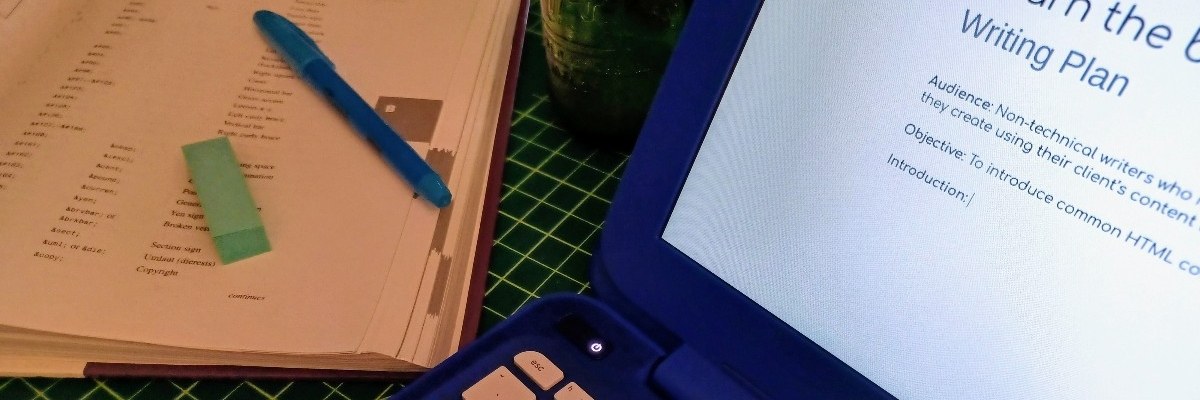
How a writing plan improves your writing
A writing plan does more than attract and keep an audience. You also benefit when you put in the time and effort to create each writing plan.
Along with planning the content, your writing plan helps you become a better writer. A writing plan makes you think about the content and organizes your thoughts. It also makes your writing time efficient, giving you time to create more content (and increase your income).
Here’s how a writing plan makes you a better and more productive writer.
Helps you reach your audience
A writing plan helps you determine the readers’ knowledge, needs, and expectations. When your writing plan is focused on the readers’ needs and desires, you’ll naturally adapt your writing style and tone to suit the audience.
By consistently considering the audience throughout the planning process, you’ll enhance your skills in communicating complex topics in a way your readers will understand.
Helps you manage your time effectively
When you break down the writing process into smaller tasks with set deadlines, you’ll learn to prioritize and allocate your time so that you meet your deadlines and reduce your stress level.
Plus, if you’re a freelance writer or want to start freelancing, your clients will be impressed with your efficiency and productivity. Happy clients always come back for more of your excellent work.
Improves thinking skills
A writing plan encourages you to think critically about the structure and organization of your writing. By outlining the main points, subtopics, and supporting details, you’ll develop a clear and logical structure for your content.
This exercise improves your skills in structuring information effectively, ensuring your writing flows smoothly and is easy to follow.
Builds research skills
A writing plan identifies the key ideas and supporting evidence the content needs to deliver your message. When you follow this process, it’s easier to develop the content in a systematic and comprehensive manner.
A writing plan helps you conduct awesome interviews, gather relevant information, conduct research, and select the most impactful details to support your arguments or convey your message.
Fosters clarity and conciseness
While outlining the main points and supporting details, you’ll learn to distill complex topics into clear and succinct statements. This practice during the planning phase helps you when you’re writing the content because you’ve trained your brain to approach the topic with clarity and conciseness.
Refines your editing skills
Even if an editor reviews your writing, it’s important to produce well-written text that’s free of errors. And your writing plan will help you become proficient at editing and enhancing your work.
Refer to your writing plan when evaluating the structure, coherence, and effectiveness of your content. Use your plan to identify areas that need improvement, such as gaps in information or weak transitions.
Creates an adaptable writing approach
While it’s imperative to stick to your plan, be open to new information you come across when writing. When you have a well-structured writing plan, you can adjust the plan and incorporate new elements while maintaining the original structure and coherence.
This approach helps you strengthen your adaptability and versatility in handling complex writing projects.

How to know if your writing plan attracts an audience
The best way to measure the success of your writing plan and the content you produced is to look at the impact your writing had on your target audience.
To measure how well your plan and content attracted an audience, review comments from readers, social media shares and mentions, and results from Analytics tools. You’ll gain the insights needed to improve future writing plans.
Use the following indicators to refine your future writing plans so that your audience definition and writing approach improve your audience engagement.
Pay attention to reader feedback
Readers leave comments on web articles, post reviews on websites, and send direct messages to the writer. Use the constructive feedback you receive to update your content and improve future writing plans.
Follow social media activity
Readers share content on social media because it’s entertaining and useful. To determine how well you attracted an audience, look at more than the number of times it was shared. Look at mentions and backlinks.
If you don’t get the engagement you expected, look at the content that interests your target audience.
If you promote your content on social media, track your content’s engagement and other metrics. Social Sprout explains how to measure the right social media metrics to determine the success of your content and marketing strategy.
Identify repeat audiences
Look for people who read your past content and return to read your current writing project. These are the type of loyal and repeat audience members you want, so make sure you represent these readers in the audience definition of future writing plans.
Use analytics tools
Tools such as Google Analytics offer insights into the number of visitors your content attracted. These tools also show which sites referred visitors to your content, how long visitors stayed on your page, and where they went after viewing your content.
Compare these statistics with the previous content you wrote to determine how well your writing plans are working.
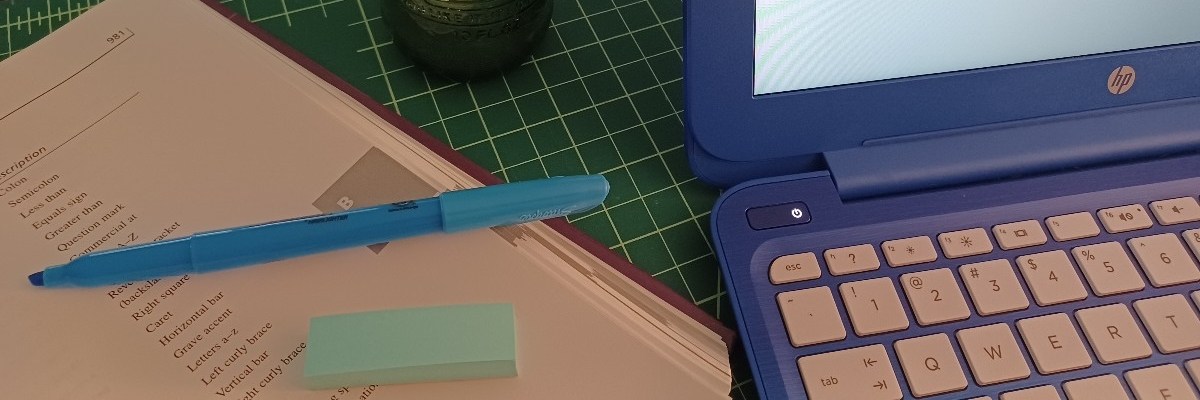
Improve your writing plan to become a more effective writer
A writing plan helps you determine your target audience, organize your content, and engage an audience that will return to read more of your writing. Along with helping you plan the article or book you’re writing, a writing plan helps you schedule time so that you meet all your writing deadlines.
When you’re finished writing, take a step back, put on your editor’s hat, and be honest with yourself. Would you want to read the piece you just wrote if you weren’t the writer?
After you publish the content, listen to feedback, observe how your audience engages with your content on social media, and use analytics tools to measure your content’s effectiveness.
And if you aren’t happy with the results, look for ways to improve your writing plan process for your future content.
FIND RELATED ARTICLES
